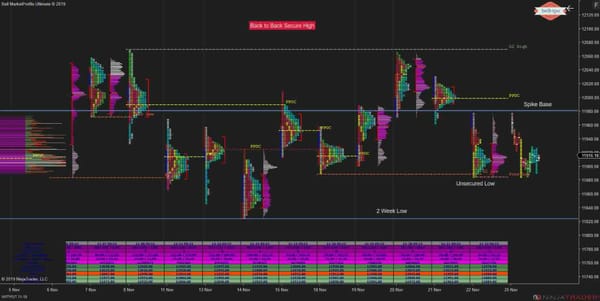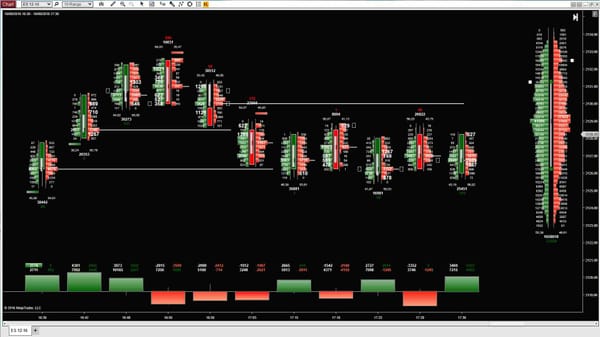MA vs. EMA vs. SMA vs. WMA – Moving Average Indicators - Guide
Explore the differences between MA, EMA, SMA, and WMA in this guide to moving average indicators. Learn which suits your trading strategy.

Moving averages are used as one of the core tools in the financial market. They help in understanding price trends beforehand by traders and analysts. Lagging technical indicators smooth out price fluctuations, helping a trader to realize valuable insight into the asset's price movement.
spxFi use order flow and market profile in our trading algorithm and services. We will discuss briefly below the advantages of each one of them.
Key Takeaways
This comprehensive guide investigates the main types of moving averages:
- Simple Moving Averages (SMA)
- Exponential Moving Averages (EMA)
- Weighted Moving Averages (WMA)
Key points discussed
- Moving averages smooth out price data to create a single flowing line
- SMAs give equal weight to all data points
- EMAs place more weight on recent data points
- WMAs place more emphasis upon recent data
- Common lengths for SMAs are 50 and 200-day periods
- Popular EMA combinations are 9 and 26-day periods
- Moving averages help define trends, support and resistance levels
- Possible buy and sell signals
Knowing such moving averages can elevate your skills in technical analysis as a day trader or long-term investor.
What is a Moving Average (MA)?
A Moving Average (MA) is a statistical tool that analyzes data points by creating a series of averages from different subsets of the complete dataset. SMAs, EMAs, and WMAs are the most prominent types of MA.
How does an MA work?
- It smooths out price data on a chart
- Creates a single flowing line
- Makes it easier to identify trend direction
- Reduces the impact of random fluctuations
Moving averages are calculated using the closing price of a security over a specified period of days. They are lagging indicators, based on past prices, but provide valuable insights into trend direction and potential support and resistance levels.
MA vs. EMA Compared
But the key differentiation between MA and EMA is the sensitivity to the recent price changes:
- MA (Simple Moving Average): Treats each data point equally over the calculation period.
- EMA (Exponential Moving Average): Exponentially weights the most recent data points, so it is sensitive to the latest price data.
Why is this important?
The increased sensitivity of EMA to recent price changes potentially leads to signals for entering or exiting trades earlier. This makes EMA quite useful for day traders who need to adjust quickly to market changes.
Comparison of SMA and EMA
SMA and EMA are the two average types, but how they are calculated and their responsiveness varies:
1. SMA (Simple Moving Average): - Treats all values equally - Calculation: The sum of closing prices divided by the number of time periods - It's a smooth line, so useful for long-term trend analysis.
2. Exponential Moving Average (EMA): - It gives more weight to recent data. - Calculated: a complex formula taking into account the previous EMA, current price, and a smoothing factor - Can react faster to price moves; good for short-term trading.
Does this impact the trade decision? The EMA will respond to the latest price changes faster, meaning that there could be earlier signals for changing trends. This greater sensitivity could also create more false signals in choppy markets.
SMA vs. MA Compared
The SMA is a type of MA with a specific method of calculation:
- SMA calculates the average price over a set period without weighting
- Other MAs, like the EMA and WMA, apply different weightings to data points.
Why is SMA considered the "standard" moving average?
It's widely used for its simplicity and ease of interpretation. SMA is particularly useful for identifying long-term trends and support/resistance levels.
WMA vs. EMA Compared
Both WMA and EMA weigh more on recent data, but they differ in structure.
1. WMA (Weighted Moving Average): - Linear weighting method - Calculation: Multiply the prices with their corresponding weights and then divide this by the total weight - Provides a flexible choice for how to weight the most recent data
2. EMA (Exponential Moving Average): - Exponential approach is used - Calculation: includes a smoothing factor based on the number of periods - Reacts quicker to recent price movements
What is the net result in trading strategies?
The WMA allows traders to assign weights to data points for a more controllable sensitivity indicator. The EMA uses a fixed formula but automatically gives a higher weight to recent prices.
What is the Simple Moving Average (SMA)
The Simple Moving Average (SMA) is the most basic form of the moving average. It calculates the arithmetic mean of a given set of prices over a specified period, giving equal weight to each price point within the period.
Calculation of SMA
The formula for calculating SMA is:
Where:
- P = Price of the asset
- n = Number of time periods
For example, a 10-day SMA would be calculated by adding the closing prices of the last 10 days and dividing by 10.
Why is SMA popular among certain traders?
It's most commonly used by swing traders and investors with longer timeframe trades and investments. SMA helps smooth out short-term price fluctuations and provides a clearer picture of the overall trend.
Common Lengths for SMAs
The most common SMAs utilized are the 50 and 200-day simple moving averages. These are popular among traders and investors for identifying long-term trends and potential support and resistance levels.
How can you access these on TradingView?
Add 'Moving Average Simple' twice to your indicators. Then, set the length of one to 50 and the other to 200 and use the daily timeframe.
Golden Cross and Death Cross
What are these important crossover patterns?
1. Golden Cross: When the 50-day SMA crosses above the 200-day SMA, considered a bullish signal.
2. Death Cross: When the 50-day SMA crosses below the 200-day SMA, seen as a bearish signal.
Why are these crossovers significant? They are popular trading patterns used by many traders to identify potential trend reversals and generate buy or sell signals.
What is the Exponential Moving Average (EMA)
The Exponential Moving Average (EMA) is a type of moving average that places a greater weight and significance on the most recent data points. Unlike the SMA, it reacts more quickly to price changes.
Calculation of EMA
The EMA uses a more complex formula that incorporates the previous EMA value:
Where:
- Close = Current closing price
- Previous EMA = EMA value from the previous period
- n = Number of periods
Why is this formula significant?
It ensures that the EMA gives more weight to recent prices, making it more responsive to new information.
Common Lengths for EMAs
Common lengths for EMAs include 9, 12, and 26 periods. These are popular among short-term traders and are often used in combination to generate trading signals.
How can you access EMAs on TradingView?
Add the 'Moving Average Exponential' to your chart and adjust the length in the indicator settings to your preference. Generally, when a short-term EMA like the 9-EMA crosses over a longer one like the 26-EMA, this is considered a bullish crossover.
What is the Weighted Moving Average (WMA)
The Weighted Moving Average (WMA) assigns a heavier weighting to more recent data points. The weightage decreases linearly for older prices, making it similar to the EMA but with a different method of calculation and emphasis.
Calculation of WMA
The WMA is calculated by multiplying each price point by its corresponding weight and then dividing by the sum of the weights:
Where:
- P = Price
- W = Weight (typically, the most recent price has the highest weight)
Why is this method useful?
It allows traders to customize the weighting based on their specific needs and market conditions.
The WMA is less popular than the SMA and EMA indicators, but it offers a middle ground between the two in terms of responsiveness and smoothing.
How to Use Moving Averages to Trade Effectively
Moving averages play a very important role in trading strategies. They can show potential buy or sell signals and help traders find support and resistance levels. So, here are some ways you can go about using moving averages in your trades:
- Trend Identification: Use over a longer period of time moving averages, such as 200-day SMA, to identify the general direction of the trend.
- Support and Resistance: This is a concept demonstrated by the dynamic support and resistance levels moving averages tend to have. Price bounces off a moving average could be a signal for the continuation of a trend.
- Crossover Strategies: Generally, two MAs of differing periods are used simultaneously for any crossover strategy. If some MA having a period smaller than some other MA crosses that other MA from below, it is normally taken as a bullish signal and vice versa.
- Multiple Timeframe Analysis: Use a combination of MAs on different timeframes to get a more comprehensive view of price trends.
- Momentum Confirmation: Moving averages help confirm momentum. If prices stay consistently above a moving average that is moving higher, this will give evidence of strong upward momentum.
- Stop Loss Orders: Stop loss orders can be used with moving averages. For example, a trader may place a stop loss just below a key moving average in an uptrend.
Why is it important to use several indicators?
Moving averages are indeed useful but ideally, they should be employed with some assistance from technical indicators and fundamental analysis.
The Best Lengths for Moving Averages
What is the best length for a moving average? This largely depends on what a trader is seeking to achieve and the prevailing market volatility. There is no just one perfect length; typical choices are:
- As a preference, short-term traders may wish to take shorter periods such as 5, 10, or 20 days in order to make it more sensitive.
- Long-term investors may choose 50, 100, or 200 days to remove noise from the market.
- Day traders typically utilize intraday moving averages - for example, 5-minute or 15-minute periods.
Why does preference differ?
A long-term trader would like the stability accompanying an SMA, while a short-term trader might prefer an EMA because it is based on more recent price data and reacts faster to changes.
Which Moving Average is the Best for Day Trading?
For day trading, many traders prefer to work with very short-period MAs such as the 5 or 10 day EMA or WMA, because it is more responsive to the latest changes in price.
The most popular set of moving averages for day traders tends to be the 9-EMA as well as the 26-EMA. This combination represents a good balance between reactivity and smoothing. Here's how day traders might use the 9/26 combo:
- Trend Direction: When the 9-EMA is above the 26-EMA, it signals a short-term uptrend.
- Entry Points: Crossovers of the 9-EMA and the 26-EMA can signal possible entry points.
- Support and Resistance: These EMAs can work as dynamic support and resistance levels intraday.
Why is testing important?
While these moving averages are very popular with day traders, you do need to test them and adjust them for your specific trading style and the assets that you are trading.
MA vs. EMA vs. SMA vs. WMA – Bottom Line
Each moving average—MA, EMA, SMA, and WMA—has its unique features and applications. Here is a brief account of each:
- SMA: Best for long-term trend identification, smoothing out price fluctuations.
- EMA: A good indicator for short-term trading and reacting quickly to price changes.
- WMA: Allows the use of different weights for recent data.
- MA (General): It is used in anything, ranging from identifying a trend to generating a trading signal.
How should you use it?
It will depend on your strategy, time frame of trading, and specific market conditions. Understanding these differences is crucial to using these tools efficiently in a trading setup.
You should bear in mind that no single indicator is perfect, and moving averages will always lag. Using these indicators along with some other tools of technical analysis combined with fundamental analysis gives the best result.
Please open a free TradingView account if you want to become adept at technical analysis, since it's used to conduct analysis of all these markets on one platform. TradingView offers unlimited charting, including all these different types of moving averages.
Your technical analysis will improve, and, therefore, you should be able to make more informed trading decisions with an understanding and proper use of moving averages. Moving averages are a valuable tool for the trader, whether he is a day trader, a swing trader, or a long-term investor.
How does Moving Average compare with Order Flow and Market Profile?
There are specific benefits to each of Order Flow, Market Profile, and Moving Averages in trading futures.
Order Flow provides a trader with real-time insight into market sentiment and liquidity by using an analysis of the buy and sell order flows to enable anticipation of short-term moves.
Market Profile provides a systematic way of looking at market information by integrating price, time, and volume data in order to visualize support and resistance areas.
On the other hand, moving averages are lagging indicators because they smooth price data over time, capturing trends on a broader scale but at the expense of the immediacy of the order flow and market profile. Each method is quite useful, depending on the trader's strategy and market conditions.
FAQs
How is WMA different from SMA and EMA?
WMA assigns linear weighting to data, SMA gives equal weight to all data, and EMA exponentially weighs more recent data. WMA and EMA are thus more responsive to price changes than SMA for the same level of the evaluation period used.
Which is a better indicator, EMA or SMA?
It's not that one is better; it just depends on your strategy. This means that EMA is more sensitive to the latest changes in price and will be more useful for, say, short-term trading. In contrast, the SMA gives a much smoother line and works great for longer trends.
What are the four moving averages?
The four main types are Simple Moving Average (SMA), Exponential Moving Average (EMA), Weighted Moving Average (WMA), and Smoothed Moving Average (SMMA). They all differ in their calculation method and implementation in technical analysis.
What is the WMA indicator?
The Weighted Moving Average (WMA) is a technical indicator that gives greater weight to data points in recent periods, with less weight on data points in earlier dates. It is more responsive than SMA but less so relative to EMA—just a balance between the two.
How do moving averages help in identifying market trends?
Moving averages smooth out the price data to easily discover trends. The longer the period of moving averages, the more this facilitates the possibility of defining long-term trends, while the shorter periods prove useful in determining points of entry/exit and analysis for short-term trends.




